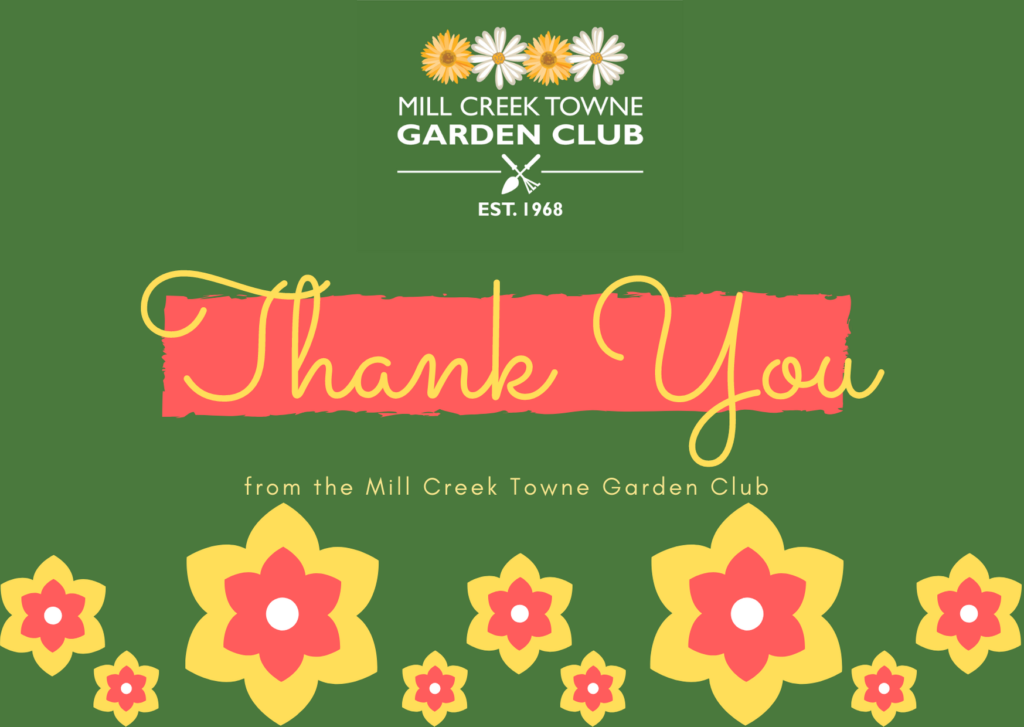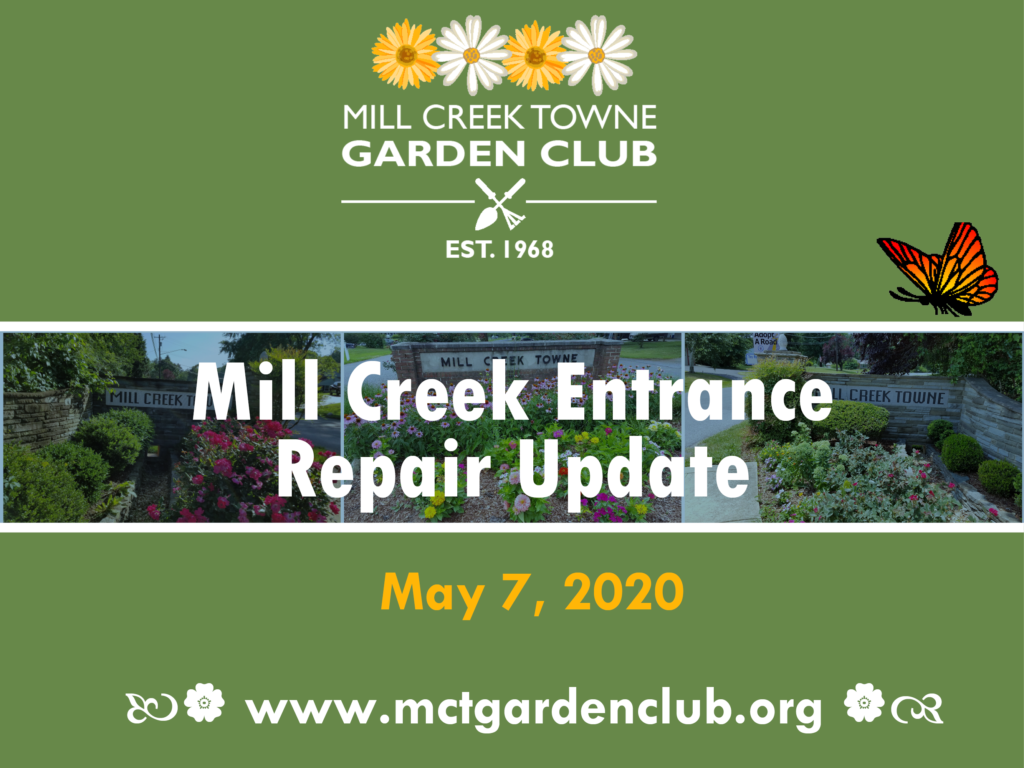Hello Friends, Neighbors, Fellow Gardeners,
Hope you are staying safe and healthy! Here are some garden tips, educational opportunities, and events for May. Because of the coronavirus, many events have been cancelled. There are some events that have been modified to online classes, check out U.S. Botanic Garden, Master Gardeners of Montgomery County, and Maryland Gardens. A lot of gardening events are announced on Facebook and we share them on our Facebook page as well as on our mctgardenclub.org website. Some live events have been set up for online preordering and limited to ensure everyone’s safety.
Planning
- Mark beds outside where your new plants from seed are going in your garden.
- Go on a virtual garden tour to see what plants are thriving in other’s area home gardens.
- Select and order fruit plants.
- Read a good gardening book or magazine.
- Have a question about gardening? Check the University of Maryland Extension’s New Maryland Grows blog for garden tips.
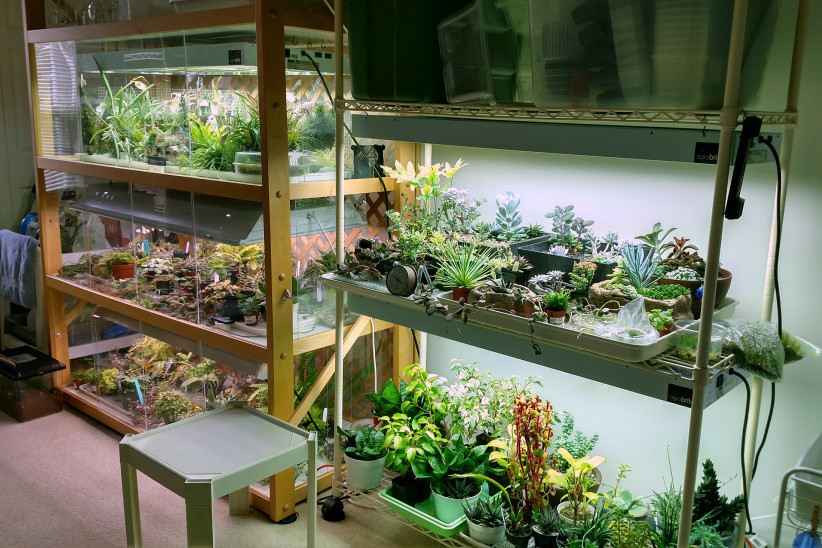
How Horticulturists Turn Quarantine Into ‘Gardentine’ | Maryland Grows Blog
- Support Our Local Farmers – Join a CSA and have fresh local produce delivered to you!
- Visit a local farmers’ market.
“During shelter-in-place, farmers’ markets remain open as an essential service, providing a vital source of fresh fruits and vegetables and food staples for our communities in a spacious, open-air setting. But our community and our farmers’ markets could be jeopardized if we don’t each do our part to stay safe during this public healthy crisis.
In good times, farmers’ markets have been places to gather and converse, however, now is the time to follow public health and safety advisories and resist the urge to linger and socialize. We all have a critical role to play in preventing the spread of COVID-19.”
How to Support Farmers and Safely Shop at Farmers’ Markets

Download Montgomery County’s Office of Agriculture 2019 Farmers Market Flyer to find a farmer’s market near you.

The new opening day for the #derwoodfarmersmarket is May 16! Preordering is now possible through the Whats Good app! More details: https://buff.ly/2xQ6zAi
Check the website for times and Covid-19 guide: https://buff.ly/2WFBSpD
Montgomery Park’s Online Plant Sale
Need plants for your yard or garden? Put in your orders for Montgomery Parks’ Online Plant Sale!
Brookside Gardens offers no-contact pick-ups appointments May 15, 16, 22, and 23.
Locust Grove Nature Center has curbside pick-ups the next two consecutive Saturdays on May 16 and May 23.
Meanwhile, Maydale Nature Classroom has only one day–May 16– for its plant pick-ups.
Learn more and order now: https://bit.ly/3btMMEk
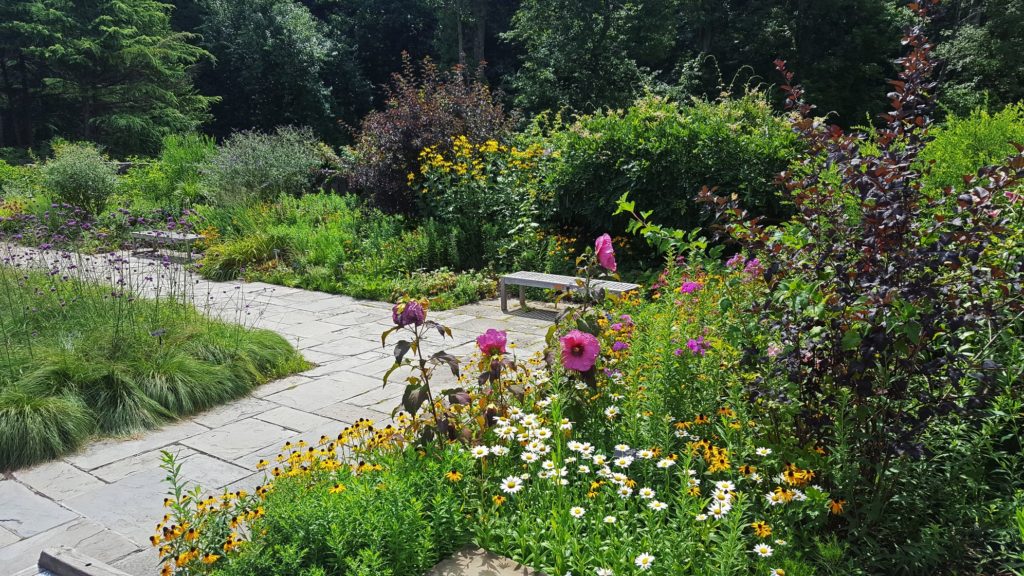
Brookside Gardens Online Classes
Brookside Gardens is adapting our programming by bringing you two free online gardening courses in May!
The first free lecture is “Perfect Plant Marriages for Spring and Summer” and will take place Saturday, May 16, from 10 am to 11:30 am. Learn more and register now: https://bit.ly/35H8ZxI.
Flowers and Groundcovers
- Directly after blooming, prune flowering shrubs and vines.
- After last frost date, plant warm-season annuals and tender bulbs (call lilies, dahlias, and gladiolus) in the ground and in containers.
- Pinch out growing tips of leggy plants.
- Plant up containers. Remove last of spring flowers, replacing them with transplants or seeds.
- Plant hardier transplants.
- Plant summer flowering bulbs.
- Begin hardening off tender transplants.
- Plant tender transplants starting around mid-May.
- Water transplants deeply when dry.
- Walk your garden — look for early signs of fungal disease.
- Divide perennials and herbs.
- Plant and prune roses.
- Fertilize transplants with 1/2 strength houseplant fertilizer (every 2 weeks)
- Weed—especially look for fast-growing vines such as honeysuckle, autumn clematis, bittersweet, wild grape, Virginia creeper, and poison ivy.
- Apply deer deterrent.
- Pests to watch for: Aphids, Deer, 4-lined plant bug, slugs, snails, spidermites, whiteflies.
- Diseases to watch for: Blackspot on roses, powdery mildew, rust, bacterial diseases.
- See UMD’s HGIC Garden Tips for more details.
- For a list of native plant resources, visit: https://extension.umd.edu/hgic/topics/native-plant-resources
Trees and Shrubs
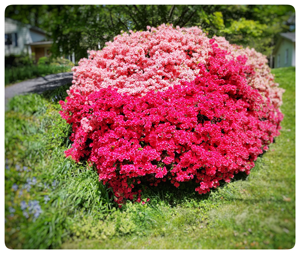
- Plant trees and shrubs that have finished blooming.
- Check often and water newly planted and transplanted trees if they don’t pass the “finger test” (stick your finger deep into the soil — dry? Water!)
- Begin planting trees when soil is not too wet.
- If you must mulch, remove old mulch, then add 2″ to 3″ shredded pine or pine needles, keeping 3″ away from trunk.
- Prune crepe myrtle when you can see what is still alive.
- Prune long shoots on shrubs to keep plant neat looking.
- Soil test established trees that have not been performing well.
- Keep mowers and trimmers away from trunks!
- Prune azaleas when they finish blooming.
- Do not fertilize newly planted or transplanted plants the first year.
- Prune out Eastern tent caterpillar egg masses.
- Test soil pH on some hydrangeas and adjust: pH 5 – 5.5 = blue; pH 6 – 6.5 = pink
- Prune broken, dead, or diseased branches.
- Prune maples, dogwoods, birch, elm, and walnut—if needed.
- Remove fallen diseased leaves.
- Mulch or compost healthy leaves.
- Put diseased leaves, pesticide-laden grass clippings and weed seeds out for recycling rather than the compost pile.
- Spray with dormant oil to decrease pest infestations.
- Remove Ivy, Pachysandra, and other vine-like ground cover from under shrubs.
- Remove dead and dying trees.
- Pests to watch for: bagworms, caterpillars, Gypsy moths, Japanese beetles, scale, sawfly, spidermites, leafminers, and voles.
- Diseases to watch for: Apple scab, Cedar-apple, hawthorn or quince rust, Verticillium wilt, Oak leaf blister.
- For more tips, see UMD’s HGIC Garden Tips for more details.
Herbs, Veggies, and Fruit
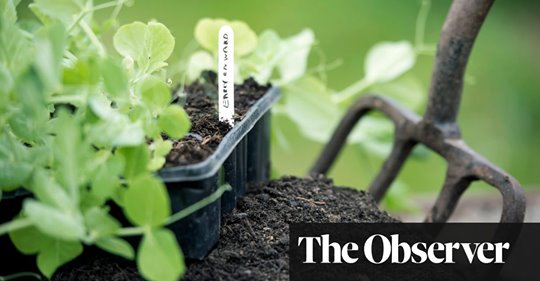
Hardening is the process of exposing transplants (seedlings) gradually to outdoor conditions. It enables your transplants to withstand the changes in environmental conditions they will face when planted outside in the garden. https://extension.umd.edu/hgic/hardening-vegetable-seedlings
- After the last frost date, plant warm-season vegetables (squash, peppers, eggplant, okra, sweet potato, tomatoes, corn, and beans).
- Sow seeds of: beans, melons, cucumbers.
- New fruit plants — keep watered their first spring, summer, and fall.
- Build a raised bed for vegetables. Add lots of manure and compost.
- All about raised beds.
https://extension.umd.edu/hgic/topics/raised-beds
- All about raised beds.
- Tomatoes are the most common and beloved vegetable crop for home gardeners. They require relatively little space and can yield 10 to 15 pounds or more of fruit per plant. https://extension.umd.edu/hgic/topics/tomatoes
- Keep all transplants watered deeply for 2–3 weeks.
- Start hardy herbs (chives, sage, thyme, rosemary), fennel, onions, and cabbage.
- Prune grapevines.
- You can still have your vegetable garden and soils tested.
- Prune dead bramble canes.
- Prune stone fruit trees like cherries, plums, and peaches.
- Apply dormant oil spray to fruit trees.
- Hand-pick cabbage worms from cabbage and broccoli.
- Pests to watch for: Asparagus beetle, aphids, cabbage worms, cutworms, rabbits, deer, woodchucks, birds
- Diseases to watch for: Apple-scab, Cedar-apple rust
- Here are some more UMD’s HGIC Garden Tips.
Planting Seeds of Wellness
Stuck in Quarantine, Gardening Sees Growth in Popularity
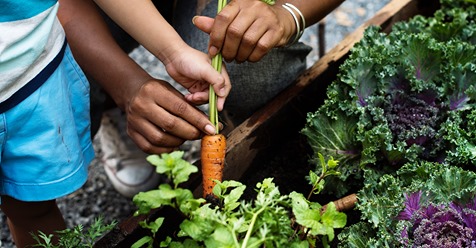
“It’s deep in our humanness to want to be connected to nature,” said Jon Traunfield, director of the UME’s Home & Garden Information Center. “It connects you to the soil. It’s very calming for people.” | UMD HGIC
Lawns
- Mow high to reduce weeds and stress. Fescue & Bluegrass: 3″ – 3 1/2″ .
- Mow zoysia grass at 2″
- To control crabgrass, apply pre-emergent herbicide to lawn (when forsythia blooms drop).
- Calibrate your spreader before fertilizing.
- Fertilize Turf only if weak: apply 1 lb. N/1000 sqft
- Control wild onions in warm season turf with broadleaf weed control.
- Clean yard of all leaves and other debris.
- Turn your compost pile.
- The annual soil science calendars from the Natural Resources Conservation Service are both educational and beautifully done. The one for 2020 as well as those for previous years are available as free PDFs here: https://www.nrcs.usda.gov/wps/portal/nrcs/detail/soils/edu/?cid=nrcseprd1250008
- Diseases to watch for: brown patch, and red thread
- Pests to watch for: Grubs
- See UMD’s HGIC Garden Tips for more details.
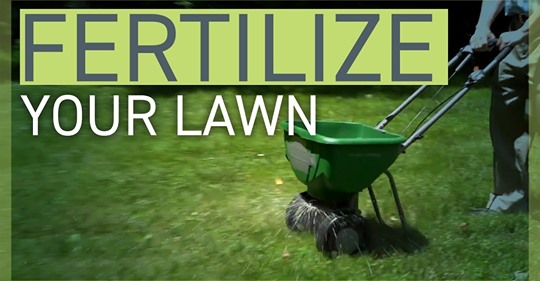
In this video we show you how to take a soil sample, determine the amount of fertilizer needed, and calibrate your spreader to have a healthy lawn while protecting the environment in Maryland. | UMD HGIC
Indoors/Houseplants
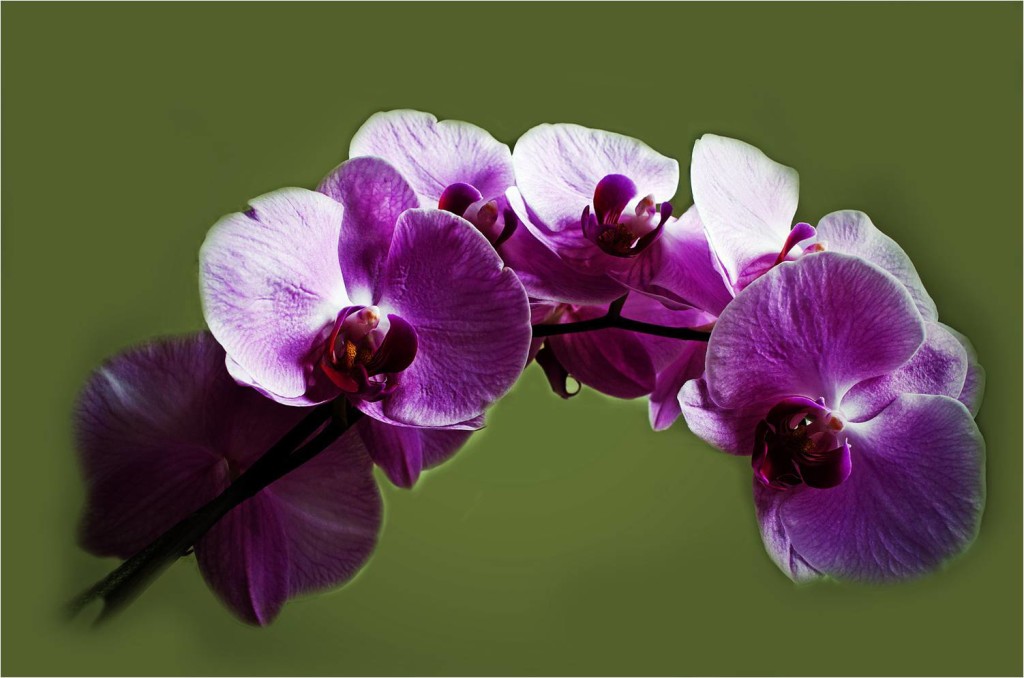
- Repot larger plants that are going outside for the summer.
- Begin hardening off prior to putting outside in shade for summer.
- Repot and fertilize houseplants when new growth begins.
- Rotate houseplants to promote even growth.
- Remove old leaves, damaged stems.
- Pinch out growing tips of leggy cuttings and plants that are overwintering.
- Clean the leaves of your indoor houseplants to prevent dust and film build-up.
- Start to fertilize with 1/2 strength houseplant fertilizer (every 2 weeks).
- Maintain moisture in pots wintering indoors, but do not over water!
- Pests to watch for: aphids, spider mites, mealybug, scale, whitefly
- See UMD’s HGIC Garden Tips for more information.
Indoor/Outdoor Insect and Wildlife Tips
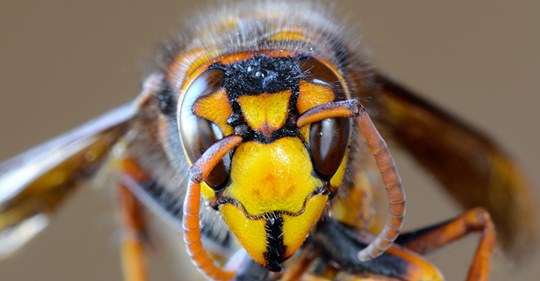
Expert: ‘Murder Hornets’ Still a Distant Threat
Let the ‘Bug Guy’ Exterminate (Most of) Your Angst About Giant Insects
https://bit.ly/3fMyqlR
- Be vigilant for mosquito breeding spots—any standing water from a bottle cap to blocked gutters—and clean them out immediately. Put Mosquito Dunks in any areas that accumulate water.
- The wild rabbit in Maryland is the Eastern Cottontail. Rabbits are abundant in both rural and suburban areas. They tend to concentrate around shrubs, overgrown fence rows, or the edge of a field. https://extension.umd.edu/hgic/topics/rabbits
- Check indoors for termites and winter ants.
- Put up birdhouses.
- Keep bird feeders clean and filled.
- Ticks are very active now.
- Switch your deer deterrent spray.
- Check for vole problems and set out traps.
- Remove and destroy gypsy moth egg masses.
- Caulk and seal your outside walls to prevent wildlife from coming indoors.
- Set out traps for mice, moles, and voles.
- Watch for: carpenter ants, flies, mosquitos, stink bugs, termites, rabbits, raccoons, groundhogs, deer, mice, moles, snakes, squirrels, and voles.
- For more information, see UMD’s HGIC Garden Tips.
Source: University of Maryland’s Home and Garden Information Center (HGIC) and the Washington Gardener.
Mill Creek Towne Garden Club News

Montgomery County MD Food and Beverage Guide
The 2019-2020 Montgomery County Food and Beverage Guide has arrived!
This year’s Guide lists over 70 MoCo Made food and beverage producers and farmers, with products ranging from honey to craft beverages to artisanal meats and more.
Master Gardener Plant Clinics
Varied Locations, dates, and times
 |
|
What can Master Gardeners do for you?
- Help you select and care for annual and perennial plants, shrubs and trees.
- Determine if you need to test your soil.
- Provide you with information on lawn care.
- Identify weeds, beneficial and noxious insects, and plant diseases and remedies.
- Teach you how to use pesticides, mulch and compost.
- Guide you in pruning trees and shrubs.
- Provide you with options for managing wildlife.
- Provide you with gardening resources.
- Help you submit a plant sample for diagnosis
Plant Clinics are held at several sites in the county on a weekly basis and at special events such as garden festivals and the county fair. Regularly scheduled Plant Clinics are located at public libraries and farmers’ markets throughout the county as well as at the Audubon Naturalist Society in Chevy Chase. There are also clinics three days per week at Brookside Gardens. The busiest season is April through September, but some clinics are open year-round. Bring your plant samples and questions to one of these locations in Montgomery County, MD (see link below to find a location near you):
https://extension.umd.edu/mg/locations/plant-clinics
Support Our Local Farmers – Join a CSA and have fresh local produce delivered to you!
CSAs are seeing record numbers of subscribers http://ow.ly/eiQT50zD5lW – find your farmer here: http://ow.ly/jbO250zD56M
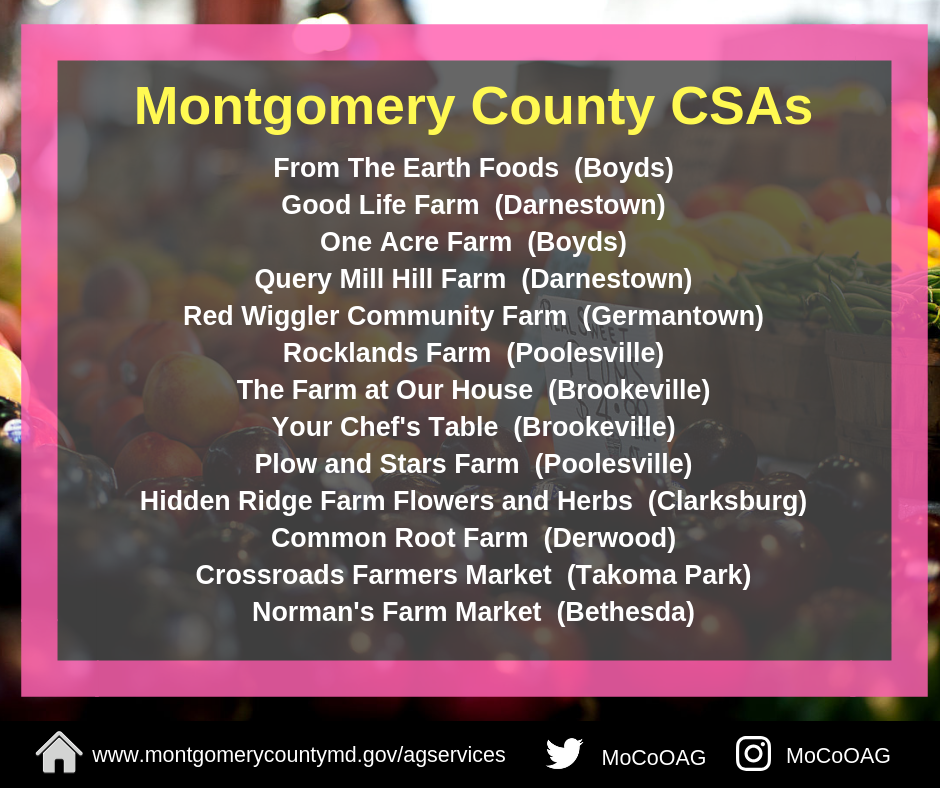
CSAs can take many forms, but essentially they are community supported farms in which members contribute to farming projects, usually by way of membership fees, in exchange for fresh, local produce. The concept came to the United States from Europe in the 1980s. They are a great way to take advantage of fresh, locally grown fruit, vegetables, herbs, and more while supporting nearby farms. Each one is different, some offer pickup locations in urban areas, some offer only farm-based pickups.
There are multiple CSAs located around the County offering a wide variety of products. CSAs begin taking sign-ups for spring and summer seasons in the early part of the year, and they tend to fill up FAST! Know of another CSA not on our list? Let us know! Montgomery Countryside Alliance also maintains a list:
http://www.mocoalliance.org/community-supported-agriculture.html




